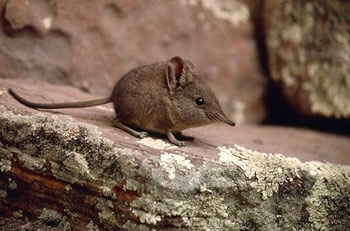A New Species of Elephantulus

A new species of Elephantulus from South Africa… unrecognized in museum collections for more than 30 years
The Karoo Rock Sengi A | B or Elephant-shrew (Elephantulus pilicaudus) has recently been described (Smit et al. 2008). This new species follows the recently discovered Gray-faced Sengi (Rhynchocyon udzungwensis) from the Udzungwa Mountains of Tanzania. The new Elephantulus is based on only 17 known specimens from five locations in South Africa. Three specimens were live trapped by Dr Hanneline Smit and her team near Calvinia (2006), two by Dr Galen Rathbun near Loxton (2001) and the remaining 12 are represented by museum specimens dating back to 1977. The new species has a limited distribution above 1300 meters in the Nama Karoo in Western Cape and Northern Cape provinces of South Africa.
The new species was first noted when studying the genetic geographical variation within the Cape Rock Sengi (E. edwardii). When sequencing DNA from tissues taken from museum specimens, large genetic differences between Cape Rock Sengi specimens across the species’ range and those from Beaufort-West and Williston, suggested the existence of a cryptic new species. Extensive field trapping followed, and great excitement was associated with the capture of three specimens by a research team from the University of Stellenbosch and the Free State Department of Tourism, Environmental and Economic Affairs. All three specimens were trapped from the farm Vondelingsfontein in the Roggeveld Mountains, 40 km south of Calvinia. A field excursion to the same locality in 2008 proved unsuccessful in trapping more specimens, which suggests that the new species is not abundant.
The detailed distribution of the new form, and its life history characteristics, are poorly known, and further studies are clearly needed to determine its conservation status. The species is apparently endemic to the Nama Karoo, which is also home to the critically endangered riverine rabbit (Bunolagus monticularis), among numerous other endemic plants and animals.
The Karoo Rock Sengi is distinguished from its sister species (the Cape Rock Sengi) by genetic sequence divergence (mitochondrial and nuclear gene regions), differences in chromosomal structure, and a suite of external morphological traits. Chromosomal differences include a centromeric shift, heterochromatic differences on autosomal pairs 1-6, and the number of nucleolar organizer regions. The subtle morphological and phenotypic characters that distinguish the new species from the mostly allopatric but phenotypically similar Cape Rock Sengi and Western Rock Sengi (E. rupestris) include the characteristics of the tail-tuft, the color traits of the hair on the flanks, and the color of the ventral pelage.
The Karoo Rock Sengi is confined to rocky areas on the slopes of mountains and boulders on ridges. Neither ongoing livestock farming nor urban development in the area directly threatens the habitat of the species. However, future agricultural activities could further fragment suitable habitat and form dispersal barriers. It is unknown whether the new species is found in protected areas other than the Karoo National Park near Beaufort-West.
The holotype of the Karoo Rock Sengi is housed in the McGregor Museum, Kimberley, Northern Cape Province, South Africa, and paratypes are located at the California Academy of Sciences (two specimens), USA, McGregor Museum (seven specimens) and Transvaal Museum (seven specimens), South Africa.